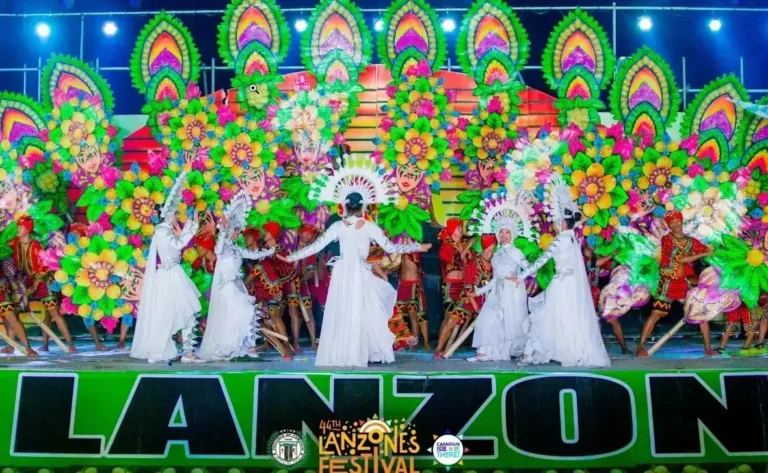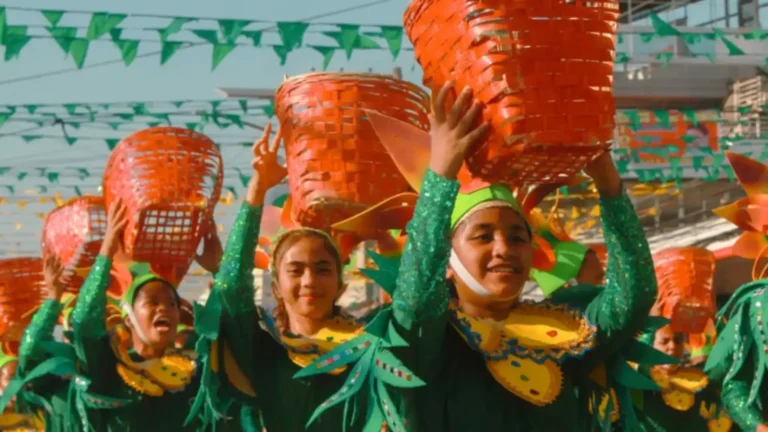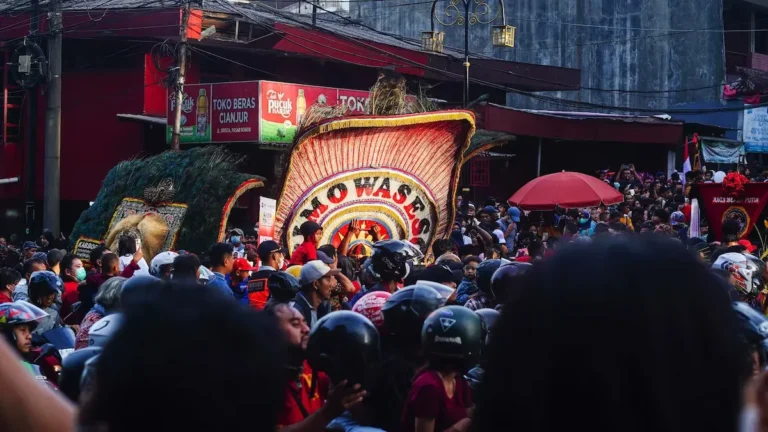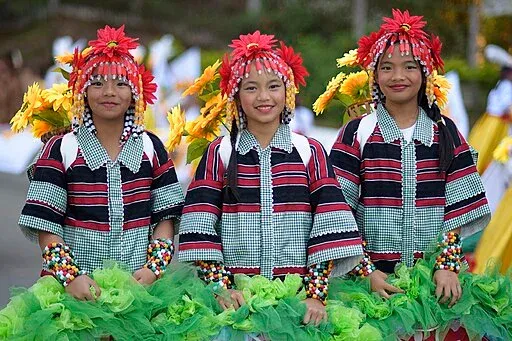Parayan Festival Philippines
Parayan Festival is a cultural festival, rice festival, and founding anniversary of the town of San Roque in the province of Northern Samar, Philippines. It is celebrated annually on March 16. The festival is a thanksgiving for a good rice harvest and a celebration of the farmers and their invaluable role in nation-building and the economy.
It is also a tourism activity that includes a dance showdown, parade, street dance, scarecrow contest, carabao contest, and booths displaying the different proud products of each barangay.
The festival is named after the Waray word “parayan,” which means bountiful rice harvest, and is dedicated to St. Isidore the Worker, the patron saint of farmers.
Key Takeaways
- Parayan Festival is a thanksgiving celebration for farmers and their contribution to the nation’s economy.
- It includes a dance showdown inspired by the swaying of rice stalks.
- The festival pays tribute to St. Isidore the Worker, the patron saint of farmers.
- San Roque, previously known as Lao-angan, became a separate municipality in 1959 through Republic Act No. 2102.
Facts About The Parayan Festival Philippines
| Facts | Explanation |
|---|---|
| Name of the Festival | Parayan Festival |
| Type of Festival | Cultural Festival |
| City of Origin | Lucban, Quezon |
| Festival Etymology | The word “Parayan” is derived from the Tagalog term “Pahiyas,” which means “precious offering.” The festival is a way for the people of Lucban to express gratitude for a bountiful harvest. |
| Date of First Celebration | May 15, 1963 |
| Founder of the Festival | Felix “Tata Usteng” Salazar |
| Brief History of the Festival | The Parayan Festival, also known as Pahiyas Festival, was first celebrated in Lucban, Quezon on May 15, 1963. It was founded by Felix “Tata Usteng” Salazar as a way to honor San Isidro Labrador, the patron saint of farmers. The festival showcases the creativity and artistry of the locals through vibrant decorations made from rice, fruits, vegetables, and other agricultural products. These colorful displays adorn the houses along the main streets of Lucban, attracting tourists and visitors from all over the country. The festival has since become a major cultural event, representing the rich agricultural heritage and strong sense of community in Lucban. |
| Brief History of the City | Lucban is a municipality located in the province of Quezon, Philippines. It was founded in 1595 and is known for its picturesque landscapes, historical sites, and vibrant cultural traditions. Lucban’s history is deeply rooted in its agricultural background, with farming being a primary source of livelihood for its residents. Over the years, it has developed into a thriving community with a strong sense of identity and pride in its cultural heritage. Today, Lucban is not only celebrated for its festivals but also for its scenic beauty and warm hospitality. |
| Ethnic Information | Majority: Tagalog Minority: Bicolano, Bisaya, Ilocano |
| Location of the City | Lucban is situated in the province of Quezon, which is located in the Calabarzon region of the Philippines. It is approximately 129 kilometers southeast of Manila, the capital city of the country. |
| How to Reach the City | By Land: – From Manila, take a bus bound for Lucena City or Tayabas City. From there, take a jeepney or tricycle to Lucban. – Private vehicles can also reach Lucban via South Luzon Expressway (SLEX) and Maharlika Highway. By Air: – The nearest major airport is Ninoy Aquino International Airport (NAIA) in Manila. From there, proceed by land transportation to Lucban. – Lucban also has a small airstrip that can accommodate light aircraft for private flights. |
| Nearby and Surrounding Cities or Towns | 1. Tayabas City (12 km) 2. Lucena City (35 km) 3. Majayjay (39 km) 4. Mauban (46 km) 5. Sariaya (48 km) 6. Dolores (53 km) 7. San Pablo City (56 km) 8. Candelaria (62 km) 9. Tiaong (69 km) 10. Nagcarlan (69 km) |
| Google Map Link | Lucban, Quezon |
| Festival Main Events | – Grand Parade showcasing colorful floats and street dancers – “Pahiyas” House Decoration Competition – Traditional music and dance performances – Street food stalls offering local delicacies – Cultural exhibits showcasing traditional crafts and arts – Religious processions honoring San Isidro Labrador – Agricultural trade fair showcasing local produce – Street parties and live entertainment throughout the festival period |
| Other Famous Tourist Attractions | By Land: – From Manila, take a bus bound for Lucena City or Tayabas City. From there, take a jeepney or tricycle to Lucban. – Private vehicles can also reach Lucban via the South Luzon Expressway (SLEX) and Maharlika Highway. By Air: – The nearest major airport is Ninoy Aquino International Airport (NAIA) in Manila. From there, proceed by land transportation to Lucban. – Lucban also has a small airstrip that can accommodate light aircraft for private flights. |
| Famous Food Dishes | – Pancit Habhab: A local delicacy made with stir-fried noodles, vegetables, and meat or seafood. – Longganisang Lucban: A savory sausage made from native pork and various spices. – Kiping: Colorful rice wafers used as decorations during the Pahiyas Festival and can be eaten after being grilled or fried. – Broas: Sweet ladyfingers made from egg yolks and flour, often enjoyed as a snack or dessert. – Kesong Puti: Soft white cheese made from carabao’s milk, commonly paired with bread or eaten on its own. |
| Landmarks in the City | – Lucban Church (Saint Louis Bishop Parish): A historic church known for its intricate architecture and religious significance. – Bahay Kubo sa Nayon: A showcase of traditional Filipino rural houses and farming tools. – Lucban Municipal Hall: A Spanish-era building that serves as the seat of local government. – Pahiyas Museum: A museum dedicated to preserving the history and cultural heritage of the Pahiyas Festival. – Kamay ni Hesus Grotto: A religious shrine featuring a series of life-sized sculptures depicting the Stations of the Cross. |
| Why They Are Famous | – Lucban Church is renowned for its Baroque-style façade and beautiful interior, attracting both religious devotees and architectural enthusiasts. – Bahay Kubo sa Nayon provides visitors with a glimpse into traditional Filipino rural life and showcases the importance of agriculture in Lucban’s culture. – Lucban Municipal Hall stands as a testament to the town’s colonial past and serves as an important symbol of local governance. – The Pahiyas Museum offers a comprehensive understanding of the Pahiyas Festival’s history and significance. – Kamay ni Hesus Grotto offers a serene setting for prayer and reflection, with its impressive sculptures adding to its religious significance. |
| Related Festivals in the Same Region | – Pahiyas Festival – Kneeling Carabao Festival – Maliputo Festival – Anihan Festival – Niyogyugan Festival |
Festival Origins and Significance
The Parayan Festival is an annual celebration held in San Roque, Philippines. It originated from the local tradition of parading and dancing with the image of San Roque, the patron saint of the town. The festival is a way for the community to express their devotion and gratitude to San Roque for his protection and blessings.
The significance of the Parayan Festival goes beyond religious devotion. It also serves as a cultural and historical event that showcases the rich heritage and traditions of the people of San Roque. The festival features vibrant street dances, colorful costumes, and lively music, creating a festive atmosphere for locals and visitors alike.
Through the Parayan Festival, the community aims to promote unity, camaraderie, and pride in their town. It also serves as a platform to preserve and pass on their cultural practices and beliefs to future generations.
Please note that while I strive to provide accurate and up-to-date information, it’s always a good idea to consult official sources or local authorities for the most accurate and detailed information about specific festivals or events.
Honoring St. Isidore the Worker
Annually, you’ll find the Parayan Festival paying homage to St. Isidore the Worker, reflecting the community’s deep-seated reverence for the patron of farmers. In this vibrant gathering, you celebrate the Parayan festival traditions and acknowledge the role of farmers in the festival, which is truly the heart of the event.
Here’s what the honoring entails:
- Thanksgiving Mass: A service dedicated to St. Isidore, asking for blessings and expressing gratitude for the year’s harvest.
- Parade of Carabaos: Decorated carabaos highlight the farmers’ indispensable companions in tilling the land.
- Ritual Dances: Performances mimic the motions of planting and harvesting, symbolizing the agricultural cycle.
- Farmers’ Market: A showcase where local farmers display and sell their produce, underscoring their contribution to the community’s sustenance and economy.
This tribute during the Parayan Festival is not just about festivities; it’s an educational experience that celebrates and honors the lifeline of the community.
Celebratory Dance Showdown
During the Parayan Festival, you’ll witness a celebratory dance showdown that captures the rhythmic essence of the rice harvest. Imagine the vibrant spectacle as each barangay showcases its unique dance routines, a harmonious blend of tradition and competition.
The dancers, adorned in colorful attire, embody cultural symbolism with every step and sway, illustrating the deep connection between the community’s way of life and the bountiful harvest they honor.
You’re not just observing a performance; you’re experiencing a living narrative, an exuberant expression of gratitude. The choreography mirrors the farmers’ toil, reflecting the cycle of planting and reaping through intricate movements.
This dance showdown isn’t merely entertainment—it’s an educational journey through the folklore and heritage of San Roque, a celebration deeply rooted in the soil of their ancestors.
Participating Barangays and Contests
As you delve into the heart of the Parayan Festival, you’ll find that participating barangays from across San Roque engage in a series of contests celebrating their agricultural pride and community spirit. Here’s what you can expect:
- Cultural Showcases: Each barangay presents its cultural traditions through vibrant performances and parades, reflecting its unique heritage.
- Agricultural Displays: Witness the competitive spirit as barangays exhibit their local produce, embracing community participation.
- Creative Competitions: From scarecrow making to carabao decorating, creativity abounds. These contests honor the hard work of local farmers.
- Culinary Contests: Taste the local flavors as communities compete in cooking traditional dishes, showcasing their culinary prowess.
These events not only foster camaraderie but also serve to educate and engage visitors in the rich tapestry of San Roque’s agricultural and cultural life.
Agricultural Product Exhibitions
You’ll marvel at the agricultural product exhibitions, where the farmers’ harvests transform into a vibrant showcase of San Roque’s fertility and farming talents. Rows upon rows of stalls display the fruits of their labor, with the rice harvest taking center stage as both a symbol of sustenance and a tourism attraction.
You’ll learn about the different varieties of rice and how they’re integral to the local cuisine and culture.
Here’s a glimpse of what to expect:
| Product Category | Featured Items |
|---|---|
| Grains | Rice, Corn |
| Vegetables | Okra, Eggplant |
| Fruits | Mango, Banana |
| Specialty Goods | Homemade Jams |
Each stand provides a unique educational experience, connecting you to the roots of San Roque’s rich agricultural landscape.
San Roque’s Historical Timeline
Delving into San Roque’s past, you’ll uncover a timeline that stretches back to its early settlement in 1762, marking the origins of a community that would eventually celebrate the Parayan Festival with pride. The festival not only honors San Roque’s cultural heritage but also significantly contributes to the local economy.
Here’s a glimpse of San Roque’s historical journey:
- 1762: The early settlement signifies the birth of a resilient community.
- 1801: San Roque becomes recognized as a visita, signaling a growth in its societal structures.
- 1872: Transition to a barrio of Pambujan, hinting at its expanding influence.
- 1959: The enactment of Republic Act No. 2102 establishes San Roque as a municipality, bolstering its autonomy and capacity for hosting landmark events like the Parayan Festival, which in turn boosts the economic impact of the festival.
Founding Day Commemoration
In celebration of the town’s autonomy, you’ll witness the vibrant Parayan Festival, which commemorates San Roque’s founding day on March 16th, marking a significant milestone in the municipality’s history. You’re not just attending a festivity; you’re becoming part of a legacy.
The streets come alive with color, music, and the spirit of community as you delve into founding day traditions.
| Event Highlights | Description |
|---|---|
| Cultural Performances | Showcases traditional dances and local talent. |
| Historical Reenactments | Depicts significant events leading to autonomy. |
| Founding Day Parade | Features floats representing San Roque’s history. |
| Community Feasts | Brings residents together in celebration. |
Educational and engaging, these events provide a window into the soul of San Roque.
Travel Guide to San Roque
To reach the vibrant celebrations of San Roque’s Parayan Festival, you’ll first need to book a flight to Catarman Airport, the gateway to this rich cultural experience. Once you’re there, immerse yourself in the festivities and savour the local cuisine, an integral part of the cultural journey.
Here’s a quick guide to ensure your visit is memorable:
- Indulge in the unique flavors of Waray delicacies, a must-try for any food enthusiast.
- Explore the scenic beaches and waterfalls, perfect for a day trip.
- Visit historical sites to connect with the area’s past.
- Engage with the locals to fully experience the town’s warm hospitality.
Prepare for an enriching cultural dive into San Roque’s most awaited festival!
Festival Venue and Accessibility
The Parayan Festival in the Philippines is held in the province of Batangas, specifically in the municipality of Lian. The festival usually takes place in the town’s public plaza or designated festival grounds.
In terms of accessibility, Lian is located along the western coast of Batangas and can be reached by various modes of transportation:
- By Car: Lian is approximately a 2 to 3-hour drive from Metro Manila, depending on traffic conditions. You can take the South Luzon Expressway (SLEX) and then continue on the Star Tollway until you reach the Batangas City exit. From there, you can follow the road signs leading to Lian.
- By Bus: Several bus companies operate trips from Metro Manila to Batangas City. Once you arrive at the Batangas City Grand Terminal, you can take a jeepney or a tricycle to Lian.
- By Public Utility Vehicle (PUV): Jeepneys and tricycles are the primary modes of transportation within Lian. These PUVs can take you to the festival venue or other parts of the municipality.
It is advisable to check the specific dates and schedule of the Parayan Festival as it may vary each year. Additionally, consider checking with local tourism offices or event organizers for any updates regarding venue and accessibility details for the festival.
Surprising Facts About The Parayan Festival Philippines
- 🌾 The Parayan Festival, celebrated in the Philippines, is renowned for its unique focus on agriculture, featuring vibrant displays of various rice varieties and traditional farming practices.
- 🎭 Unlike many festivals, Parayan incorporates theatrical performances and skits that highlight the challenges and triumphs of Filipino farmers, adding a touch of drama to the festivities.
- 🚣♂️ One of the festival’s distinctive activities is the “Balsa ng Parayan,” where locals creatively decorate bamboo rafts to showcase their agricultural heritage while floating along scenic waterways.
- 🌱 In an eco-conscious twist, the Parayan Festival encourages tree-planting initiatives as part of the celebration, emphasizing environmental sustainability and the importance of preserving nature.
- 🍚 A surprising feature is the “Rice Sculpture Contest,” where talented artisans craft intricate sculptures using different types of rice, showcasing their creativity and skill in transforming this staple crop into artistic masterpieces.
- 🎤 Celebrating the oral traditions of the community, the festival hosts a unique “Harana sa Parayan,” a serenade competition where participants express their emotions through traditional love songs.
- 🏞️ In a nod to the country’s rich biodiversity, the Parayan Festival integrates a “Native Flora Parade,” highlighting the diverse plant life indigenous to the region.
- 🚴♀️ Fitness enthusiasts are in for a surprise with the “Bisikleta sa Parayan,” a cycling event that combines physical activity with cultural appreciation, as participants pedal through scenic routes showcasing the festival’s essence.
- 🍲 Foodies rejoice during the “Parayan Culinary Challenge,” where local chefs showcase their culinary prowess by incorporating rice in innovative and delicious ways, creating a feast for the senses.
- 🌏 Emphasizing unity and global awareness, the Parayan Festival includes a “Cultural Exchange Fair,” providing a platform for locals and international visitors to share their customs, fostering a spirit of global understanding.
Conclusion
In conclusion, the Parayan Festival in San Roque, Philippines, stands as a vibrant celebration rooted in agricultural heritage, community spirit, and gratitude to St. Isidore the Worker. From the dance showdowns inspired by rice stalks to the historical richness of Lucban, the festival offers a profound cultural experience. As you engage in the festivities, you not only witness the artistic expressions of the locals but also contribute to the economic vitality of the region.
The Parayan Festival serves as a bridge connecting tradition, agriculture, and community, inviting both locals and visitors to immerse themselves in the heartbeat of this lively and significant cultural event.
Frequently Asked Question
What is the Parayan Festival?
The Parayan Festival is a cultural, rice festival, and the founding anniversary celebration of the town of San Roque, Northern Samar, Philippines, held every March 16. It celebrates the rice harvest and gives thanks to the Almighty for a bountiful yield, honouring the hard work of rice farmers. The festival includes a variety of activities like parades, street dances, contests, and more, with participation from different barangays.
What does “Parayan” mean?
“Parayan” is a word from the Waray language that refers to a rice harvest. The festival is named after this term to reflect its focus on celebrating the plentiful rice harvest and the essential role of rice farming in the local community and economy.
What are some of the activities at the Parayan Festival?
The Parayan Festival features numerous activities including a Thanksgiving Mass, a grand parade, street dancing, agro-tourism fairs, and technology transfer workshops. It also hosts competitions such as the search for Parayan King and Queen, scarecrow and carabao contests, floor show dancing competitions, and showcases of local products through public street displays.
How can one attend the Parayan Festival?
To attend the Parayan Festival, one can book a flight to Catarman Airport and then take a land trip to San Roque, which is about 60 kilometres away. The festival is a significant event that attracts participation from the various barangays that compose the town, making it a vibrant and inclusive celebration of the local culture and agriculture.





